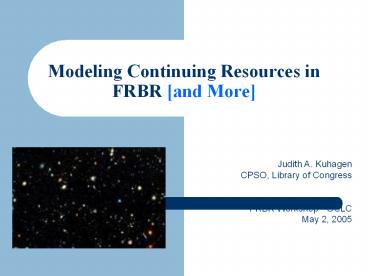Modeling Continuing Resources in FRBR [and More] PowerPoint PPT Presentation
1 / 26
Title: Modeling Continuing Resources in FRBR [and More]
1
Modeling Continuing Resources in FRBR and More
Judith A. Kuhagen CPSO, Library of
Congress FRBR Workshop - OCLC May 2, 2005
2
Continuing resources
- Bibliographic resource issued over time with no
predetermined conclusion - Serials
- Ongoing integrating resources
3
Serial
- A continuing resource issued in a succession of
discrete parts, usually bearing numbering, that
has no predetermined conclusion. - Includes magazines, electronic journals, annual
reports, newspapers, monographic series
4
Integrating resource
- A bibliographic resource that is added to or
changed by means of updates that do not remain
discrete and are integrated into the whole - Continuing (or finite)
- Includes updating loose-leafs and updating Web
sites
5
Challenges of continuing resources?
- Seriality
- Number of records per cataloging codes
- Range of relationships, especially for serials
6
Seriality
- Susceptibility to change over time
- Title(s)
- Responsible persons/bodies
- Publisher, manufacturer, etc.
- Numbering
- Content
- Physical carrier
- Etc.
7
How is seriality of serials handled in cataloging
codes?
- Number of records
- One record, or
- Multiple (successive) records
- Description in record
- Based on latest issue, or
- Based on earliest issue
8
How is seriality of integrating resources handled
in cataloging codes?
- Often not in general cataloging codes (e.g., not
in AACR2 until Dec. 2002) - Principle of single record based on latest (i.e.,
current) iteration/state of resource - Update single record as resource changes
- Reality sometimes multiple records for single
resource due to difficulties in identification of
resource
9
What is a serial work?
RCA series on safe climbing (v. 1-7) changed
to Safe climbing series of the Rock
Climbing Association (v. 8-12) changed
to Safe climbing series of the RCA (no. 1-
3 works or 2 or 1?
10
If work-ness is related to number of records
- If issues on previous slide cataloged per AACR2
Dec. 2002 1 record based on v. 1 - If cataloged per AACR2 prior to Dec. 2002 3
records, each based on earliest issue of each
segment - If cataloged prior to AACR 2 records one
record for 1st 2nd titles based on v. 8
another record for 3rd title
11
Relationships of serials
- Earlier/later within the same serial
- Earlier/later beyond the same serial
- Mergers, splits
- Alternate editions
- Language
- Physical medium
- Reproductions
- Whole/part
- Considered most important by IFLA FRBR CR Group
12
Earlier/later within the same serial
- Proposal consider that all segments of a serial
(represented by one or multiple bibliographic
records due to different methods of accommodating
seriality) together equal one serial work - Important
- Be able to find
- Be able to identify
13
Earlier/later beyond the same serial
- Proposal doesnt mean condensing all serials into
only a few mega-serials - New serial works when chronological relationship
is not a one-to-one relationship - Mergers
- Splits
14
Alternate editions
- Important beyond finding and identifying, being
able to select - Users preference/need for language
- Users preference/need for physical format
15
Reproductions
- May not be issued/released with same mode of
issuance as the original - Should be considered as same to satisfy the
users need to find and identify surrogate for
the original - Users need to select preference/need for
different physical format
16
Whole/part
- Some serials and integrating resources are
aggregate resources (work of works), e.g. - Monographic series volumes
- Journals issues, articles
- Loose-leaf services monographs, serials,
integrating resources - May or may be bibliographic record for resource
as a whole local decision
17
is component of
Continuing resource content
Title has has has Editorial version
Linguistic version
is published as represents Publication
has
Physical version general type
has Physical version
specific type is materialized
as Set of Individual Individual
issues issues, is part of issue
is part of bound together complete
is part of
Patrick Le Bœuf 25aug04
18
Other resources with seriality?
- Yes, behavior not affected by intended end
- Finite integrating resources
- Multipart monographs
- Somewhat easier to manage
- Identifying what is a work/expression
- Number of records usually only one
19
What adjustments to FRBR model?
- Acknowledging seriality of resources (noted in
Areas for further study) - Reconsidering some attributes
- Another mode of issuance streaming resources
20
Acknowledging seriality
- Attributes of a manifestation now only for
concurrent manifestations - Different title, place of publication, publisher,
series, physical medium, etc. - Need concept of consecutive manifestations of
same work/expression - Change in title, place of publication, publisher,
series, physical medium, etc.
21
Reconsidering some attributes
- Redefining some expression attributes as
belonging to manifestation, e.g., - Expected regularity of issue (serial)
- Expected frequency of issue (serial)
- Considering if edition/issue designation, now at
manifestation level, should also be at expression
level for some serials
proposal from the CONSER Task Force on FRBR and
Continuing Resources
22
Streaming resources
- From work of Carol Van Nuys and her colleagues in
Paradigma Project - Consider
- Resources themselves vs. how resources
represented by bibliographic records - Attributes same or different?
23
Non-bibliographic model
- Using work authority record next two slides as
examples - From Barbara Tilletts presentation at American
Library Association (Jan. 2005)
http//www.ala.org/ala/alctscontent/serialssection
/serialscomm/ contresourcecata/2005midwintermeetin
g.htm
24
(No Transcript)
25
(No Transcript)
26
Questions/Discussion?

